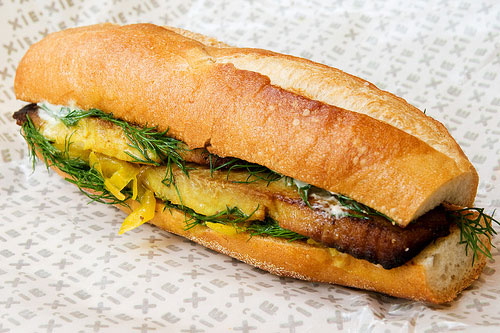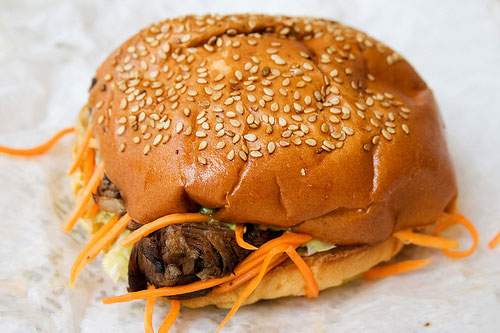
Caption: All photos by Robyn Lee.
I always get nervous when I hear chefs or restaurateurs talking about "concepts" -- as in, replicable concepts that can be cloned around the city (and around the world) as part of a brand roll-out. (In fact, it always makes me nervous when chefs start talking about "brands" and "roll-outs.")
So when I heard that Xie Xie (Mandarin for "thank you," pronounced shay shay) was a sandwich concept rather than a sandwich shop -- complete with a second location already secured -- I was worried.
I liked chef-partner Angelo Sosa's cooking at his short-lived Yumcha, and he has an impressive résumé, having worked for Jean-Georges Vongerichten for two years. So I know the dude can cook. But replicable concepts are much more difficult to pull off than they appear, so I really didn't know what to expect from Xie Xie.
Xie Xie is not a banh mi joint, and it's not a hero shop. It most resembles a slightly more elegant and stylized Pan-Asian version of Num Pang. (Really, if George Jetson opened an Asian-inspired sandwich shop, this is what it would look like.) "After my last stint with Jean-Georges I spent a year cooking in Asia," Sosa says. "The menu at Xie Xie is based on culinary impressions that were left during my travels."
To make the concept more cloneable, Sosa has limited the menu to five savory items. It does put a lot of pressure on those five sandwiches to be terrific, because there aren't many places to turn if one or two of the sandwiches turn out to be clunkers. But that's all right by Sosa. "I wanted to create five signature dishes," he told me.
Fish Cha Ca La Vong ($8.75) is unlike any fish hero sandwich I'd ever had, perhaps because I've never been to Hanoi. A large slab of tilapia is enlivened by a trio of condiments: onion jam, sriracha mayonnaise, and fresh dill. It is inspired by a dish Sosa had in Hanoi at Cha Cha La Vong, a 200-year-old restaurant that, according to him, serves only one dish -- a river fish cooked in tumeric oil and finished with dill.
Sosa calls the Sweet Glazed Pork ($9) a deconstruction of a Chinese steamed pork bun (char siu bao). That's a fairly apt description. The housemade rice flour mini-buns were quite stiff by the time our sandwiches arrived back at the office (maybe this sandwich isn't made to travel) but the pile of slow-cooked and shredded pork shoulder marinated in hoisin sauce, oyster sauce, sesame oil, and soy is mighty, mighty tasty -- especially when you insert a sprig of fresh cilantro and dip the whole thing in the "sweet and sour condiment." The strained marinade then magically becomes the sweet glaze.
What is the sweet and sour condiment? A combination of rice wine vinegar, chili oil, and pickled shallots. (Shallots are Sosa's secret weapon.)

Vietnamese BBQ Beef ($9) is a couple of thick hunks of braised, ginger-and-lemongrass-marinated short rib with a burnt sugar glaze on a sesame seed bun. His special sauce is a basil mayo, with a nod towards Korea in the carrot kimchee that tops the sandwich. It's the Asian-inspired equivalent to a Jewish deli brisket sandwich with Russian dressing and cole slaw.
Shredded braised chicken ($8.50) comes with a dab of smoked egg salad that is not, in fact, actually smoked. "We cook eggs in soy broth and add smoked bacon and cook it for 6 hours," said Sosa. "Then we hold it for one month in a chilled state." I don't know whether I loved or hated it, but I knew I had never tasted anything like it before.
What's Asian about the Asian Lobster Roll ($14)? It's made with the sweet and creamy Japanese Kewpie mayo. The fresh tarragon brings the sandwich back to western European territory, as do the seriously delicious crispy shallots. (I'd like to see crispy shallots served everywhere. Wouldn't you?) It is a fine lobster roll, made with delicately cooked Nova Scotia lobster meat. Is it worth $14? Lobster's expensive -- that's the bottom line.
The "1,000 Year Old" ice cream sandwich ($4) is a fine, fine chocolate cookie ice cream sandwich stuffed with vanilla ice cream, with a burnt black fleur de sel caramel center. (Why thousand-year old? It's a long story.)
Sosa and his crew make the oversized and brittle Xie Xie fortune cookies ($3). They're a lot more buttery than your average fortune cookie; the delicious yuzu cream is a Sosan riff on lemon curd.
So far, Sosa has made the concept work. There isn't a loser among the five sandwiches on the menu, though I remain unmoved by the shredded braised chicken sandwich. Any one of the other four sandwiches, the ice cream sandwich, and a delicious Red Jacket Orchard juice (by far the best and most interesting item on the beverage list), would make an excellent (if pricey) lunch.
What will happen when and if Sosa and company do embark upon a course of global domination is anyone's guess. But for now, we have ample reason to give thanks for Xie Xie. If it and Num Pang represent the beginning of a trend, so be it. Asian-inspired sandwich shops presided over by talented chefs are okay in my book. Just don't call them brands.